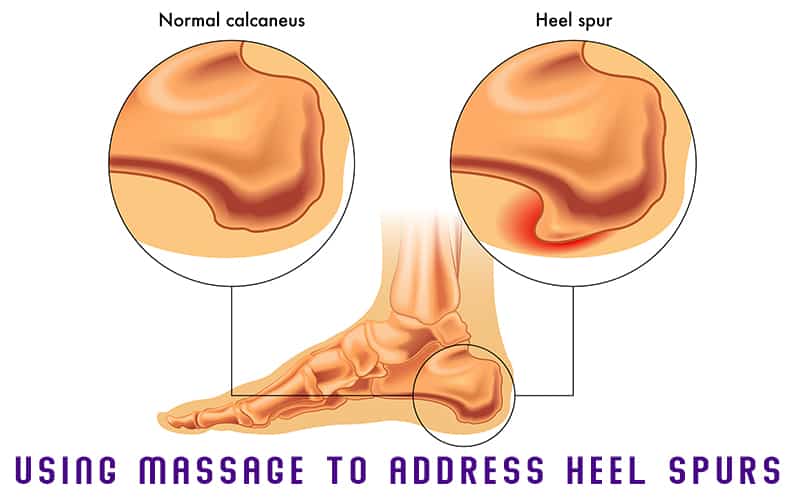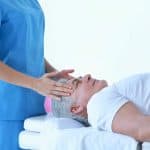

 Want to earn continuing education credit for this article? Learn more.
Want to earn continuing education credit for this article? Learn more.
Often associated with plantar fasciitis, heel spurs are troublesome bony growths on the bottom of the foot. While heel spur prevention is far simpler than treatment, there are still a wide range of therapeutic interventions. Involving more than a gentle, relaxation massage, deep tissue work holds great rewards for heel spur sufferers.
About Heel Spurs
Otherwise known as a calcaneal spur, a heel spur is a growth of calcium around the ligaments and tendons of the foot where they attach to the calcaneus. The spur grows outward from the bone and into the soft tissue of the foot.
Usually from repetitive overuse, this calcified deposit is due to inflammation that occurs from constant trauma to the calcaneus. This is because:
- The tissue surrounding the calcaneus is not very vascular.
- The byproduct of inflammation (exudate) has very few ways to be carried away from the area.
- After a period of time, this exudate will calcify.
- Repeated heel inflammation will cause greater amounts of calcification, a process that eventually forms a heel spur.
Despite the common misconception that a heel spur is sharp and produces pain by pressing on nearby tissue, they are usually smooth and flat and rarely cause pain on their own. However, calcaneal spurs can lead to callus formation as tissue builds up, providing added cushion over the area of stress. Over time, wear and tear on joints may cause these spurs to compress neighboring ligaments, tendons or nerves, thus injuring tissue and causing swelling, pain and tearing.
Heel Spur Treatments – Conventional
Unless they are causing frequent pain or damaging other tissues, bone spurs by themselves rarely require treatment. However, calcaneal spurs that have not been addressed can lead to extreme, disruptive pain. Because heel spurs and plantar fasciitis are so closely related, they are usually treated the same way. Conventional symptomatic treatment involves:
- Rest – It is important to stop the inflammation, especially from the offending activity (like running).
- Ice – Easing inflammation immediately following an aggravating activity will help reduce further exudate accumulation.
- Stretch – Daily, gentle lengthening of the gastrocnemius will relax the tissue surrounding the calcaneus.
- Medications – Over-the-counter or prescription-strength anti-inflammatory medications can help relieve pain temporarily, but are not intended for long-term use.
- Arch Support – Shoe inserts or custom orthotics help prevent over-stretching and consequent inflammation of the foot’s plantar surface.
- Steroid Injections – Highly controversial due to potentially serious side effects, steroid injection at the painful site may bring relief.
- Surgery – Usually a last resort, bone spurs can be surgically removed during which time the plantar fascia is loosened.
Heel Spur Treatments – Additional Approaches
Many of the therapeutic interventions listed above are essential to recovering from a heel spur, but they do not stand alone. These other approaches also have a deserved place in heel spur therapeutics:
- Night Splints – Night splints are worn to keep the heel stretched during sleep. They prevent the arch of the foot from becoming contracted at night, which reduces pain.
- Ultrasound – A device that applies high frequency sound vibrations to create a deep heat and reduce inflammation, ultrasound is commonly applied for heel spurs by physical therapists.
- Hydrotherapy – Placing the feet in a warmed whirlpool bath directly on a jetted stream can help increase blood circulation to relax and loosen the plantar fascia.
- Acupuncture – By increasing circulation within the feet, acupuncture can reduce inflammation and plantar tension while moving exudate out.
- Natural Anti-inflammatories – For those that suffer gastrointestinal upset from OTC medications supplements such as ginger, turmeric or Boswellia could help reduce inflammation and pain.
Heel Spur Treatment – Massage Therapy
Simultaneous employment of a variety of the treatments listed above can help reduce plantar foot pain. However, adding skillfully applied massage therapy to a heel spur treatment program will amplify the potential for pain relief.
Because the heel and plantar surface of the foot is covered by a lot of tough tissue, regular massage is likely to be ineffective. On the other hand, those trained in deep tissue massage can begin to dissolve calcification – a crucial step for heel spur healing. The deep massage goals for a calcaneal spur, include:
- Producing direct heat on the calcification.
- Increasing adjacent tissue elasticity.
- Increasing arterial blood flow.
According to Zhenya Kurashova Wine, an educator and proponent of Russian Medical Massage, offers the following guidelines to help massage therapists achieve these deep tissue goals:
- With the client prone and feet resting on a support at least six inches high, work the arch with circular pressure stretching.
- Once the arch is pliable, focus circular pressure stretching on the client’s heel. Because the actual spur may be tender, it will likely take some time to increase the depth of massage.
- As the arch area will retains its pliability with subsequent treatments, less time will be required for the client’s arch.
- Since the area being worked is very small, only an inch or so of tissue will be covered.
- The therapist should consider using his or her knuckles or similar approach because thumbs are likely to be strained by this work.
Many people suffer needlessly from nagging heel spurs and accompanying plantar fasciitis. Because there are so many therapeutic options that complement each other – including deep tissue massage – bodyworkers can play an integral role in relieving their clients’ feet pain.
Earn continuing education credit for this article contained in our Foot Pathologies series. Click here to enroll.















